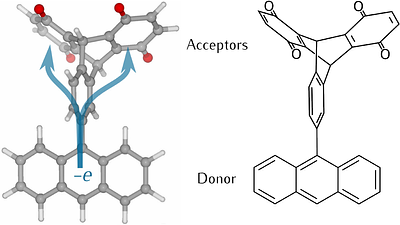By: Hanggai Nuomin, Feng-Feng Song, Peng Zhang, David N. Beratan
Molecular structures with multiple donor, bridge, or acceptor units can display quantum interference effects that influence electron and energy transfer (ET and EnT) rates. Recent experiments found a 4- to 5-fold increase in ET rates for donor-acceptor structures with two acceptors compared to one. This result is surprising: simple classical or quantum analysis suggests a factor of two rate enhancement. We analyze the coupling interactions in... more
Molecular structures with multiple donor, bridge, or acceptor units can display quantum interference effects that influence electron and energy transfer (ET and EnT) rates. Recent experiments found a 4- to 5-fold increase in ET rates for donor-acceptor structures with two acceptors compared to one. This result is surprising: simple classical or quantum analysis suggests a factor of two rate enhancement. We analyze the coupling interactions in multiple acceptor systems and find that rate enhancements beyond additive effects arise from acceptor-acceptor interactions that: 1) shift the reaction free energy, 2) change the donor-acceptor couplings, and 3) alter the reaction-coordinate motion. Consideration of these effects explains the observed rates in multi-acceptor systems and suggests strategies to tailor energy and electron transfer kinetics. less
By: Julia Liebert, Christian Schilling, David A. Mazziotti
We develop a systematic framework for the spin adaptation of the cumulants of p-particle reduced density matrices (RDMs), with explicit constructions for p = 1 to 3. These spin-adapted cumulants enable rigorous treatment of both S_z and S^2 symmetries in quantum systems, providing a foundation for spin-resolved electronic structure methods. We show that complete spin adaptation -- referred to as complete S-representability -- can be enforced ... more
We develop a systematic framework for the spin adaptation of the cumulants of p-particle reduced density matrices (RDMs), with explicit constructions for p = 1 to 3. These spin-adapted cumulants enable rigorous treatment of both S_z and S^2 symmetries in quantum systems, providing a foundation for spin-resolved electronic structure methods. We show that complete spin adaptation -- referred to as complete S-representability -- can be enforced by constraining the variances of S_z and S^2, which require the 2-RDM and 4-RDM, respectively. Importantly, the cumulants of RDMs scale linearly with system size -- size-extensive -- making them a natural object for incorporating spin symmetries in scalable electronic structure theories. The developed formalism is applicable to density-based methods (DFT), one-particle RDM functional theories (RDMFT), and two-particle RDM methods. We further extend the approach to spin-orbit-coupled systems via total angular momentum adaptation. Beyond spin, the framework enables the adaptation of RDM theories to additional symmetries through the construction of suitable irreducible tensor operators. less

